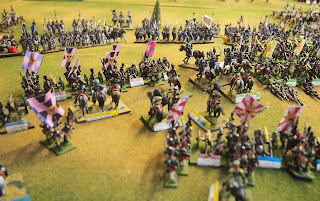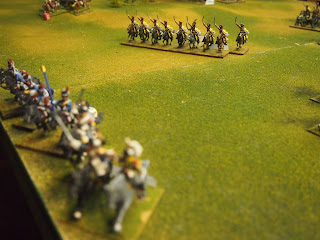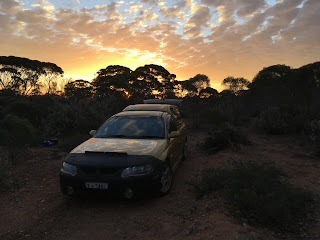In our last episode, I reported that the French were "looking good" across the battlefield. This left us pondering, could it all be over by lunchtime (in real time and also game time)?
Before I launch into what occurred on Saturday, the third day of the game, I'd like to reply to some questions that were asked in response to my previous post.
Looking down the driveway at the venue for the game, aka Tim and Jill's garage. We were 15 players in all, including me; seven French and eight allied.
The game began on Thursday evening (3/1), after a barbecue dinner, around 18:00; or perhaps it was more like 19:00? Anyway, that night we played about ten turns (I think), finishing around 22:00 or so—each turn representing about 15 minutes of real time. The turns that night were reported in part two of this series of posts.
On Friday (4/1) we re-commenced play at 09:00, with a brief break for morning tea, about an hour for lunch, a rolling afternoon tea and further time out for dinner. We ceased play around 22:00 (see part three).
Saturday's play, the subject of this post, began a little more leisurely at 09:30.
Tim remembered that he had specially painted some limbers for the game, but had forgotten to deploy them. I quickly jumped in and said that I'd use them with the guns of I Corps (Stephen, honorary member of our ANF, would approve!).
The rules that the NWA fellas use are called 'Cold Steel'. They are a house set of "Empire successor" rules developed by the NWA Napoleonic wargamers. Ben 'Rosbif' has a link to the latest version on his blog (see the tabs for Cold Steel rules and charts). Those familiar with Empire will recognise the base for the rules, but they have been simplified and edited considerably over the eight versions. They are a detailed set, arguably too detailed for such a large-scale game. Indeed, several of the fellows mentioned that they are not completely enamoured with them. Nevertheless, they work and work well. The players all come together in the spirit of enjoying the game, camaraderie and fellowship so that the weekend and the game is a completely wonderful and enjoyable event. To help with moving the game along, each side is give 15 minutes on the 'penguin' (an egg-timer in the shape of a penguin) to complete their turn. This is ignored for particularly involved turns, but is a great way to keep things moving.
The table is some 24’ x 14‘. Referring to one of my reports from the first NWA big game that I attended back in 2014, I said that:
There is a central table that is 24’ x 4’ around which are ‘layers’ of 8’ x 2’ tables. These latter are on casters so can be wheeled in and out as need for game play, over-view of the battle—and photos.
I think that Tim may have increased the length of the table a bit since then and may even have added another set of tables on wheels, but you get the idea of the immensity of the set-up.
This year's game was dedicated to two members of the group who have sadly passed away; Peter and Jim. I was most fortunate to have met them both and to have played wargames with them. Lovely gents.
To the action from Saturday (5/1)!
Soult and d'Hautpoul continued from where they left off, driving north-west in the general direction of the Pratzen heights (away to the top right of the photo, well out of camera shot).
I Corps (Bernadotte, yours truly) consolidated, ready to take the lesser heights on Soult's left.
On Bernadotte's left, Murat's heavy cavalry continued to face-off with Liechtenstein's troopers.
In the north, Lannes and Bagration continued their arm-wrestle.
In the south, Oudinot's 'grenadiers' had helped to stabilised the French position.
With the Russian 12 pdr battery temporarily withdrawn, my 8e ligne attacked the isolated Russian infantry (those guns represent battalion guns).
Not successful on this occasion, taking minor casualties and two disorders.
In the south, Davout was getting the upper-hand over Keinmeyer's advance guard...
... while Legrand faced off against Langeron.
This left Oudinot's 'grenadiers' free to move towards the Pratzen heights.
Back in the north, Lannes had established a strong position opposed to Bagration.
Back in the centre, that d@mned 12 pdr battery had deployed again, so I sent infantry of 1st division to outflank it, some Cossacks had other ideas...
... but thought better of it when they saw the steady French infantry.
More cheeky Cossacks over on Soult's right, in what seemed an isolated attack.
They were however, followed by Constantine and the Russian Guard.
The same viewed from the allied perspective.
The Guard Hussars drove off some French cuirassiers, but then took some flank fire from Soult's infantry.
Next it was the turn of the Guard infantry (once again, the guns represent battalion guns).
They accounted for a foot battery,
... then broke-through on the square behind.
The Russian Guard Hussars, 'charging' while blown, cleared away the next French gun,
... but did not have sufficient impetus to break the square beyond that.
My stout fellows from 1st division again tried to outflank the Russian position,
... being only partially successful.
Suddenly, it seemed that everyone was activated, with charges across the table.
In the north, Bagration's light cavalry took on light and heavy cavalry from Murat's reserve.
With mixed results.
A unit of cuirassiers was caught in the flank,
... but the Russian hussar's breakthrough onto the infantry square was not to be one of those rare successes of history.
On the left of I Corps the ground shook as the heavies came to grips—each side rolling a one!
That produced something akin to a nil all draw.
(It was Tim's fourth '1' in a row. His dice that afternoon were awful).
On the Pratzen Heights, Kutusov prepared his line.
Oudinot's men launched an aggressive attack and made some headway.
With Rivaud's 1st division infantry of I Corps pulled back from the 12 pdrs, Nansouty sent in the supporting cuirassiers.
Success! How to follow-up?
Soult had reformed his troops following the attack of the Russian Guard.
The action continued across the table.
Light cavalry chequers in the north.
Oudinot pressing on the heights.
Legrand and Davout beginning to join up their lines in the south.
Back with I Corps, Rivaud prepared for a division assault to finally take the hill,...
...but the sight of Russian horse guards (or perhaps chevalier guards), coupled with 'Sire's' orders to 'keep them occupied and not do anything rash' stayed Bernadotte's hand.
The stalling of the French attack in the centre did not matter as Legrand and Davout had achieved wonders in the south. First one and then the other of Docturov's brigades retreated, followed later by Langeron's.
Similarly in the north, where Lannes was now in clear control.
In fact, it was only in the centre that the allied line held.
They can been seen in this photo, clinging to the 'edge of the world' (top left of photo).
At this point (Saturday night) the game was called as a French victory.
Let's do a quick recce. of the table.
Lannes ascendant in the north, what is left of Bagration in the foreground.
To the left of Lannes, Liechtenstein and Murat's cavalry back to facing off.
I Corps' still in reasonable shape, but failed to take 'that hill'.
The Pratzen heights back in French hands.
In the south, the allied left flank n'existe plus!
Interestingly, the plans of both sides had failed. The allies intended to use Buxhowden's wing (Langeron and Docturov) as the hammers against the anvil of Kollowrath with the Guard and cavalry joining in the assault. The French had intended to break the allied centre and then swing right (or left) as befitted the situation. While the French attack on the centre achieved some success, it was blunted by some dour defence, hesitant attack (especially by Bernadotte) and the Russian Guard's counter-attack. So it was that the brilliant success of Davout and Legrand (in particular), and Lannes' holding action which became a local victory along with the successful attack on the Pratzen heights that decided the day.
While not the utter rout of history, the French victory was significant and may well have lead to the treaty desired by Napoleon. It would have tested the theory of historians such as Alistair Horne who have assessed that Napoleon's compete victory at Austerlitz contributed to the on-going wars and his eventual downfall. One can only ponder such alternative histories.
It was a fabulous game. A huge, public thank you to the wargaming hosts with the most, Tim and Jill and to all of the NWA Napoleonic group for allowing me once again to join them for their special, annual mega-game. Thank you all.
After the packing up on Sunday, I did some more visiting of rellies in Vic. and SA that afternoon/evening, Monday and Tuesday. I left Adelaide to hit the road in earnest on Tuesday afternoon, reaching WA early afternoon on Wednesday.
I had my biggest drive that day (1 254 km), stopping at a marvellous camp spot west of Caiguna.
Up before dawn for the 885 km trundle home.
So, just after lunch on the 10th Jan. the VU-Au was parked up in front of the Ralph Fisher Memorial room.
Epilogue
Part two of this series of posts stimulated a bit of discussion about summer temperatures in different environments across the world. We had one of our common, hot summer days yesterday (max. over 41ºC), with a cool change to 37ºC today ahead of mid to low 30s for the rest of the week, and associated cool nights of around 15ºC (my personal preferred summer pattern). It's a much drier environment than Drouin, especially in summer, but there is plenty of beauty.
Here's one amazing example, that we have not previously seen. This normally orange-flowered Bougainvillea has, on one branch, both orange and purple flowers. It's wonderful to see the ranges and changes in the landscape and vegetation as one drives across Australia, but there are always wonders in one's own front yard. Isn't nature wonderful?!



































































